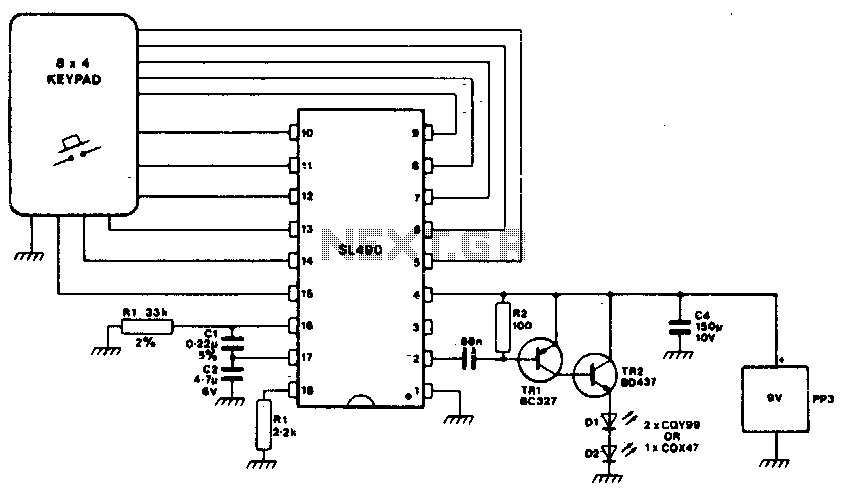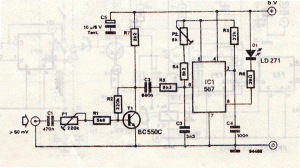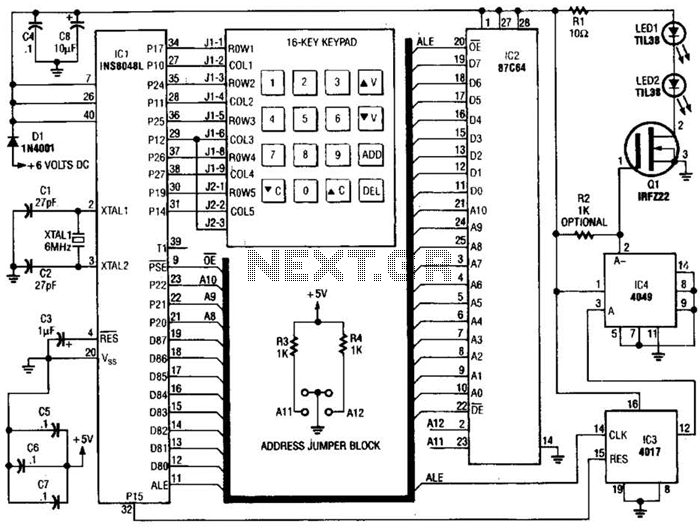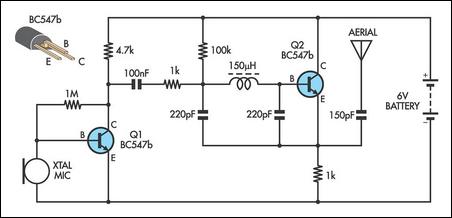
500mW Broadcast FM Transmitter

This compact FM transmitter operates with an RF output power of 500mW and can be powered by a 12-15V battery or power supply. The signal is modulated using frequency modulation (FM) techniques and employs four transistors. The transmitter consists of four stages and consumes approximately 100-150mA of current. The circuit is designed to operate around a frequency of 100 MHz, which can be adjusted by modifying the coil. An audio signal is introduced to the tank circuit through a 5 pF capacitor and a 10K ohm resistor. The modulation level is regulated by a 1N4002 rectifier diode. The output stage of the FM transmitter functions as a class D amplifier, where the output transistors operate as switches.
This FM transmitter circuit is designed to provide a reliable and efficient means of broadcasting audio signals over short distances. The four-transistor configuration allows for effective amplification and modulation of the RF signal. The use of a class D amplifier in the output stage contributes to high efficiency, minimizing power loss and heat generation, which is particularly beneficial in battery-operated applications.
The transmitter operates in the VHF band, specifically around 100 MHz, which is suitable for many audio broadcasting applications. The frequency can be fine-tuned by adjusting the coil, allowing for flexibility in operation and enabling users to avoid interference with other radio services. The audio modulation is accomplished through a combination of the 5 pF capacitor and the 10K ohm resistor, which form a coupling circuit that feeds the audio signal into the tank circuit, ensuring that the modulation is effectively applied to the RF carrier wave.
The 1N4002 diode plays a crucial role in managing the modulation depth, ensuring that the audio signal is rectified properly, which aids in maintaining signal integrity. The overall design prioritizes simplicity and effectiveness, making it accessible for hobbyists and professionals alike. The compact nature of the circuit also allows for easy integration into various devices or systems requiring FM transmission capabilities. The careful selection of components ensures that the transmitter operates efficiently within the specified power range, making it suitable for various applications, including personal broadcasting and experimental radio projects.This little broadcast FM transmitter has 500mW of RF output power and runs of 12-15V battery or power supply. DC whose signal modulated by FM using four transistors. Transmitter includes four transmitter stages and draws around 100-150mA of current. Using the values of the circuit components, the frequency will be around 100 MHz but can be changed via coil.
Through the 5 pF capacitor and 10K ohm resistor, the modulation of audio signal is supplied to the tank circuit. The amount of modulation is being managed by the 1N4002, a general purpose rectifier diode. FM Transmitter`s output stage is functioning as a class D amplifier where the output transistors act as a switch.
. 🔗 External reference
This FM transmitter circuit is designed to provide a reliable and efficient means of broadcasting audio signals over short distances. The four-transistor configuration allows for effective amplification and modulation of the RF signal. The use of a class D amplifier in the output stage contributes to high efficiency, minimizing power loss and heat generation, which is particularly beneficial in battery-operated applications.
The transmitter operates in the VHF band, specifically around 100 MHz, which is suitable for many audio broadcasting applications. The frequency can be fine-tuned by adjusting the coil, allowing for flexibility in operation and enabling users to avoid interference with other radio services. The audio modulation is accomplished through a combination of the 5 pF capacitor and the 10K ohm resistor, which form a coupling circuit that feeds the audio signal into the tank circuit, ensuring that the modulation is effectively applied to the RF carrier wave.
The 1N4002 diode plays a crucial role in managing the modulation depth, ensuring that the audio signal is rectified properly, which aids in maintaining signal integrity. The overall design prioritizes simplicity and effectiveness, making it accessible for hobbyists and professionals alike. The compact nature of the circuit also allows for easy integration into various devices or systems requiring FM transmission capabilities. The careful selection of components ensures that the transmitter operates efficiently within the specified power range, making it suitable for various applications, including personal broadcasting and experimental radio projects.This little broadcast FM transmitter has 500mW of RF output power and runs of 12-15V battery or power supply. DC whose signal modulated by FM using four transistors. Transmitter includes four transmitter stages and draws around 100-150mA of current. Using the values of the circuit components, the frequency will be around 100 MHz but can be changed via coil.
Through the 5 pF capacitor and 10K ohm resistor, the modulation of audio signal is supplied to the tank circuit. The amount of modulation is being managed by the 1N4002, a general purpose rectifier diode. FM Transmitter`s output stage is functioning as a class D amplifier where the output transistors act as a switch.
. 🔗 External reference





